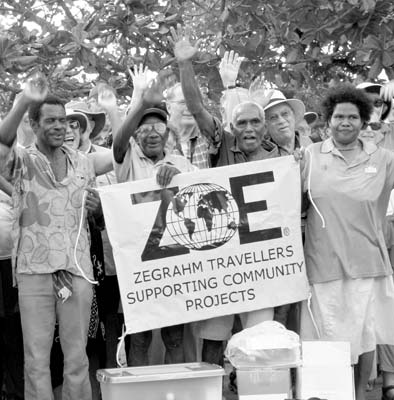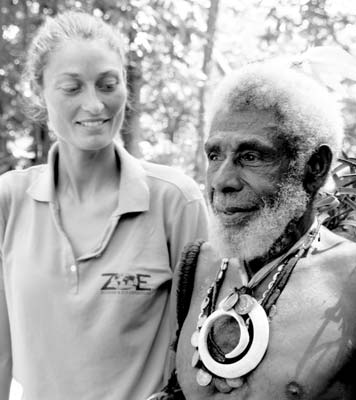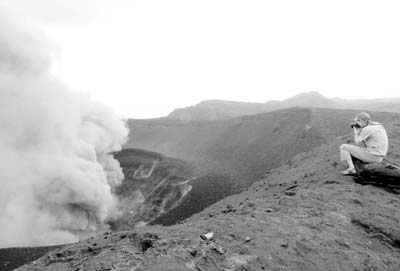Sailing through paradise with Zegrahm
Have you “been there, done that” with big-ship cruises in the Caribbean, Alaska and the Mediterranean? Maybe it’s time to try one of the most exotic cruises on Earth, with Zegrahm Expeditions aboard the intimate Clipper Odyssey, from New Guinea to Vanuatu across the southwest Pacific Ocean.
This is the South Pacific at its finest, with gorgeous coral atolls, visits to tiny, isolated villages little changed since the time of Captain Cook, lots of World War II history, and great snorkeling, diving, natural history and bird-watching.
My wife, Susan, and I participated in the “Faces of Melanesia” cruise expedition in November 2006. Zegrahm chartered the 335-foot Clipper Odyssey for the voyage. Highlights included the expedition management, the ship, the joys of a typical day and the attractions of the itinerary.
Expedition management was provided by Zegrahm, and it was extremely impressive. Air and visa arrangements, predeparture information, on-board organization, customer orientation and daily planning all were world class. The Zegrahm staff worked incredibly hard and was wonderfully friendly and responsive throughout the entire cruise. In traveling to over 179 countries and territories, I have never seen a harder-working group of travel staffers.
We boarded the Clipper Odyssey in Port Moresby, Papua New Guinea, after a short flight from the delightful town of Brisbane, Australia.
The vessel is a well-designed expedition-style ship with only 64 cabins; cabins were refurbished in 2006. Zegrahm generally sails with a maximum of only 110 passengers, depending on single occupancy, so the ship has a very intimate feel and you can really get to know your shipmates. On our voyage there were 106 passengers and 12 Zegrahm experts and staff.
The Filipino crew was very friendly, and officers were Australian, British and American.
There are no casinos or big theaters on board. Instead, the focus is on visits to remote islands inaccessible to larger vessels, and on Powerpoint talks on natural history and local culture by experts in the ship’s main lounge. The ship features a well-stocked library.
After sailing out from Port Moresby, our first stop was a village of only 150 inhabitants on remote Bruner Island in the Milne Bay district of southeast Papua New Guinea. This introduced us to a typical expedition day.
In the morning we headed for shore in Zodiacs, landed on the beach and were met by excited children dressed in native costume who laughingly pretended to “attack” us “invaders” with spears and arrows.
Next, the distinguished-looking village chief introduced local folk dances performed by the villagers. Their exotic costumes, long grass skirts, white feather headdresses and white face paint made for fantastic photo opportunities.
Dancing was followed by a tour of the village led by the village chief and Peter Zika, an expert Zegrahm naturalist, who pointed out breadfruit, sago palms, mango trees and other items of interest.
The 15 keen birders in the expedition hiked up toward a lighthouse on the ridge behind the village and came back reporting that they had seen a rare trumpet manicode (a form of bird of paradise), a variable goshawk and a hooded butcher bird. Papua New Guinea is one of the best places on Earth for seeing exotic bird species. The birding walk was led by expert Greg Homel, who has seen over half of the world’s 9,800-odd bird species — an incredible feat.
After an excellent informal lunch back aboard the Clipper Odyssey, we went snorkeling. We marveled at the gorgeous fish, colorful coral and clear, pristine waters. Jack Grove, Zegrahm’s cofounder and one of the world’s top experts on the fish of the Pacific, led the snorkeling group and pointed out particular fish and corals, giving us tips on how to observe their behavior.
The 10 to 12 divers on board got an even better view of the sea life. On some occasions they dove down to the limit of recreational diving — 125 feet — and came back with great stories and excellent underwater videos of the fish and shipwrecks they had seen. The expedition offered one to two dives per day for certified divers but did not offer dive instruction.
That afternoon we enjoyed a fascinating lecture by Mary LeCroy, one of the experts on board, on “The Birds of Paradise.” Mary had researched these birds for decades for the American Museum of Natural History in New York and had gorgeous slides and sketches of the many types of this exotic bird.
In the evening we attended the daily, hour-long “recap,” where the expedition leaders and experts each spoke briefly about what they had seen and heard that day. Zegrahm’s divemasters Natalia and Thomas Baechtold often showed video footage of what the divers had found. Set to soothing music, these short presentations were some of the best underwater videos I have ever seen, much better even than the typical footage seen on professional television shows.
Then it was time for a tasty, satisfying dinner — a great social occasion. Zegrahm’s expeditions provide the chance to meet fascinating passengers in an open-seating, always-casual meal format and listen to their stories from all over the world. Typical passengers included a member of the Travelers’ Century Club with over 300 countries and territories under his belt, an expert in city preservation, and the former chairman of the Institute for Nautical Archaeology.
The overall itinerary for the trip was varied and exotic. Island stops in Papua New Guinea included the famous Trobriand Islands, one of the birthplaces of anthropology as a science, where Bronislaw Malinowski did some of the first real studies in cultural anthropology from 1915 to 1918.
In the Solomons the ship visited John F. Kennedy Island, a tiny atoll where the future president swam ashore in World War II after his famous PT-109 was cut in half by a Japanese destroyer.
We were touched as World War II veterans on board laid a wreath in Iron Bottom Sound, where many U.S. sailors perished in the Battle of Savo Island, one of the few major defeats suffered by the U.S. Navy. And we visited famous Guadalcanal, site of a great U.S. victory in that historic conflict.
We also saw the wreck of the famous expedition ship World Discoverer, which ran aground in narrow Sand Fly Passage on Florida Island, north of Guadalcanal.
A major highlight of the itinerary was visiting the incredible volcano Yaser on Tanna Island in Vanuatu (the former New Hebrides). This volcano honored us with a huge ash cloud and dramatic explosions so intense, I could see the shock waves compressing the air and pulsing out from the lava chamber far below.
Coming back down the slopes of the volcano, I realized that I had been fortunate to experience one of the most exotic and amazing voyages on Earth.
Zegrahm will take the Clipper Odyssey on a similar voyage, titled “Faces of Melanesia,” for 16 days beginning Oct. 31, 2007. Prices will start at $8,780 per person, including gratuities, all meals and all tours and excursions except a few special scuba dives. Round-trip economy airfare from Los Angeles is expected to be about $1,975 per person.
Contact Zegrahm Expeditions (192 Nickerson St. 200, Seattle, WA 98109; 800/628-8747, www.zeco.com).
Lew and Susan Toulmin were guests of Zegrahm Expeditions but paid for their airfare, drinks, laundry and incidentals. Lew is the author of “The Most Traveled Man on Earth,” available for $16.95 plus $5 shipping from The Village Press (13108 Hutchinson Way, Silver Spring, MD 20906; www.themosttraveled.com).



